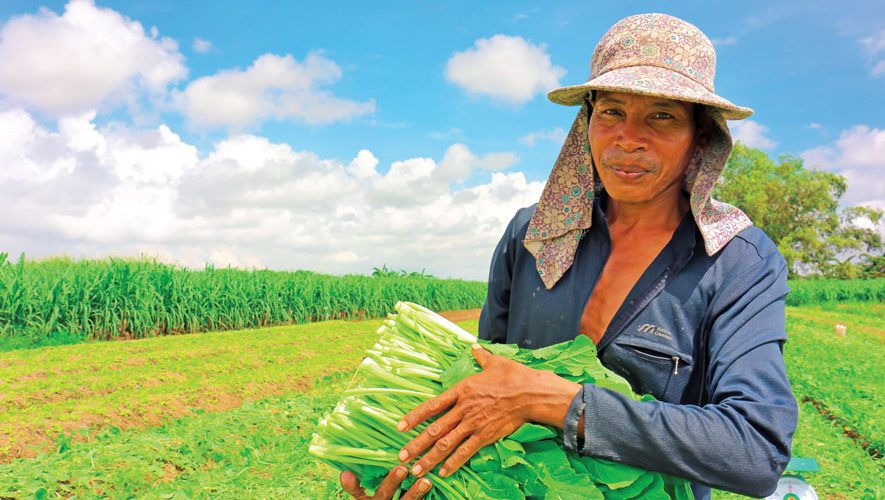Despite European Union-imposed tariff on rice exports, drought, and other challenges, Cambodia’s agricultural sector is expected to see growth in the coming years.
For the latest Cambodian Business news, visit Khmer Times Business
Its agricultural output and export figures promise to exceed with the entry into new markets, better farming methods, assistance and investment from other countries.
Srey Vuthy, spokesman of the Agriculture, Forestry, and Fisheries Ministry (MAFF) says the optimism is reinforced by the fact that more agro-processing factories will start operation this year.
He was referring to several foreign-owned agricultural processing facilities including a Korean-owned fruit processing plant in Kampong Speu.
Vuthy adds that Cambodia is expected to export more rice in future which is good news for a nation where agriculture plays a critical role in economic development.
Agriculture and Cambodia
Agriculture has long been an important part of Cambodian life. In the past, agriculture not only anchored the country’s economy but it was also the source of livelihood for its people.
Today, not much has changed. A bulk of Cambodia’s population still lives in rural areas with some saying that as much as 80 percent of the Kingdom’s population lives outside urban areas.
Currently, nearly 50 percent of the country’s population is directly connected with the farming industry but the figure rises to 65 percent if communities reliant on fishery and forestry industries are included.
Between 2004 and 2012, Cambodia’s agriculture scene was considered the ‘Golden Age’ with annual growth averaging five percent. In that period, the sector was instrumental in bringing out more than four million people from poverty.
Last year, the sector grew 1.78 percent, accounting for more than 30 percent of Cambodia’s gross domestic product (GDP) compared to some 25 percent in 2017.Growth was largely contributed by increased production and more countries buying Cambodian products like rice, rubber, cashew, and fruits.
Key agricultural products, new markets
Rice is Cambodia’s leading agricultural produce. Last year, it produced 10.9 tonnes of rice, marginally higher than 10.5 tonnes in 2017. Of that, 626,000 tonnes were exported to more than 50 countries, namely China, Vietnam and Europe.
Rice production in Cambodia is mostly concentrated in Battambang, Kampong Thom, Kampong Cham, Kandal, Prey Veng and Svay Rieng provinces.
Rubber plantations spread over 430,000 hectares in Kampong Cham, Kratie, Kampong Thom, Rattanakiri and Mondulkiri, produced some 140,000 tonnes of latex for export in the first nine months of 2018 versus 115,063 tonnes in the corresponding period a year ago.
The Kingdom also has more than 140,000 hectares of cashew plantations which saw a harvest of 140,000 tonnes in 2017, mostly exported to Thailand, China and India.
South Korea has promised to buy more produce from Cambodia as the nation looks to export more products to Central Asia, and Middle East.
Ongoing challenges
One of the major challenges to the sector is EU’s rice safeguard imposition but the government assures that there is nothing to worry about as there are alternative markets for rice exports.
However, World Bank has identified poor infrastructure and lack of access to technology, and extension services on the part of farmers.
Cambodia still lacks adequate farm-to-market roads and irrigation systems. Although new technologies for planting of high-yield seed varieties, modern fertiliser and pesticide application concepts are available, most farmers still practice old farming methods.There is also a shortage of processing facilities, and weak health and safety standards.
A helping hand from ADB, China, other countries
The Asian Development Bank (ADB) is extending grants and concessional loans of $70 million for the sector.
Hunan Hybrid Rice Research Centre (HHRRC), a leading Chinese authority on hybrid rice, promised to share its technology and technical expertise.
Pagoda, a giant Chinese fruit retailer, also offered to process and package Cambodian fruits, and export to China where the demand for fresh and process fruits is growing rapidly.Cambodia is a major producer of mango, durian, rambutan, longan, lychee, mangosteen, jackfruit and banana.
Cambodia’s farming industry has also received assistance from the US, EU, Japan and Korea.
The future is bright
Barring major catastrophes, Cambodia’s agriculture industry is expected to develop further in the next few years.However, both the government and private sectors agree that there is still much work to be done to overcome the challenges. As Cambodia’s Agriculture Minister Veng Sokhon puts it, “…farming in the country has seen remarkable growth (but) more work needs to be done”.




